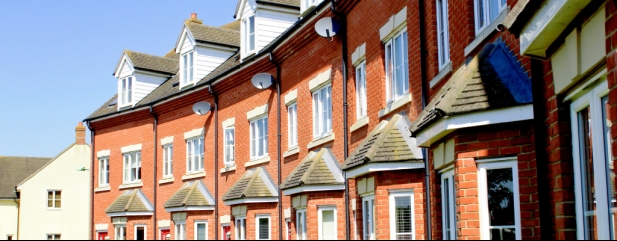Archived article
Please note that tax, investment, pension and ISA rules can change and the information and any views contained in this article may now be inaccurate.
Property versus pension: which one is a better investment?

For nervous investors worried about the volatility of stock markets, investing in housing may seem like a safer, less bumpy alternative, but the facts don’t support this seemingly popular view.
Duncan Lamont, head of strategic research at Schroders, says investing in global stocks has been the superior strategy whether you look back over the last five, 10, 15, 20 or 30 years.
For example, £100,000 worth of UK property purchased 25 years ago would have been valued at £454,000 on average in December 2022 based on Land Registry and Refinitiv data, while the same amount invested in global stocks (ignoring any costs) would have been worth around £631,000.
These figures mask significant regional variations with London property worth around £580,000 and Scotland at the other end of the spectrum, worth £407,000. It is also worth reminding readers that the housing data exclude costs of ownership such as maintenance, repairs, insurance or taxes.
In short, stocks have historically provided better financial returns than houses. Investing in stocks via tax sheltered accounts such as ISAs and SIPPs (self-invested personal pensions) adds to their relative attraction.
That said, one cannot say with certainty that a pension will continue to do better than property as investments can fall as well as rise in value. There are also looming challenges for the housing market which suggests property may not perform as well as it has done over the last 25 years.
WHAT WE CAN LEARN FROM HISTORY
It is sometimes blindly stated that house prices tend to always rise in the long run, but the historical record suggests that isn’t the case. For example, between 1845 and 1911 UK house prices fell 23%.
Over the same period average household earnings almost doubled (+90%) which resulted in the average house price to income ratio falling from over 12 times to around two times in the early part of the twentieth century.
The cult of house ownership didn’t really take hold until the second half of the twentieth century with ownership rates steadily rising from around 20% to a peak of 70% in 2000.
Meanwhile, the ratio of house prices to average earnings rose to the current 9 times based on data as of 30 November 2022.
A working paper by the Bank of England published in December 2019 argued a big contributing factor behind the rise in average house prices to average earnings between 1985 and 2018 was ‘a sustained, dramatic, and consistently unexpected, decline in real interest rates as measured by the yield on medium-term index-linked gilts.’
In other words, lower interest rates allowed borrowers to take on more debt without increasing its relative affordability. But the central bank warned that an ‘unexpected and persistent increase’ in the medium-term real interest rate of 1 percentage point from its level at the end of 2018 could ultimately cause up to a 20% fall in real house prices over the following years.
Mortgage interest costs have ballooned in the past few years as central bank rates shot up. The Bank of England data for July 2023 shows the average interest rate on new mortgages rose to 4.66%, the highest since 2008. Meanwhile, mortgage approvals fell 20% year-on-year, more than economists were expecting.
My home is my pension
People often think of their home as their pension. They believe it will go up in value enough so they can sell it at retirement and live off the proceeds. What is often forgotten is the need to still have a roof over their heads for the rest of their life.
That means either using some of the sale proceeds to buy another home, potentially downsizing, or renting which means a steady outflow of cash.
COULD HOUSING SEE A REDUX OF THE 1850s?
Lamont at Schroders identifies three important factors which led to houses becoming more affordable relative to incomes in the 1850s. Increasing supply was a major factor with the housing stock doubling to 8.9 million.
Making smaller houses such as terraced homes instead of detached ones was also a key driver while homes in all categories fell in average plot size.
Lastly, average earnings grew 90% over the period – when combined with falling house prices this led to a dramatic fall in the ratio of house prices to incomes, making a house purchase easier to finance.
Putting rising interest rates to one side for a second, could the same dynamics play out over the next few decades and drive down the ratio of house prices to earnings? The recent government record doesn’t look promising.
In 2019 the Conservatives set a target to build 300,000 new homes a year by the mid-2020s but last year only 233,000 homes were built.
For reference in the 1960s around 350,000 new homes a year were supplied. Today’s equivalent of the smaller dwellings of the 1850s is the government’s focus on building affordable housing, but the supply has been lower than envisaged.
Meanwhile, the cost-of-living crisis and sky-high inflation has reduced real incomes. In short, solving the undersupply of new housing remains a thorny problem.
Important information:
These articles are provided by Shares magazine which is published by AJ Bell Media, a part of AJ Bell. Shares is not written by AJ Bell.
Shares is provided for your general information and use and is not a personal recommendation to invest. It is not intended to be relied upon by you in making or not making any investment decisions. The investments referred to in these articles will not be suitable for all investors. If in doubt please seek appropriate independent financial advice.
Investors acting on the information in these articles do so at their own risk and AJ Bell Media and its staff do not accept liability for losses suffered by investors as a result of their investment decisions.
Issue contents
Feature
Great Ideas
News
- State pension set to go up by 8.5% from April 2024
- How deal-hungry CVS became a dog with fleas
- Could Restaurant Group’s leisure disposal lead to a full break-up?
- Without fanfare, Berkshire Hathaway shares have climbed to all-time high
- Oil surge is reigniting fears over inflation as Brent hits $91 per barrel
- Burford Capital’s $16 billion court win is not a done deal

 magazine
magazine








